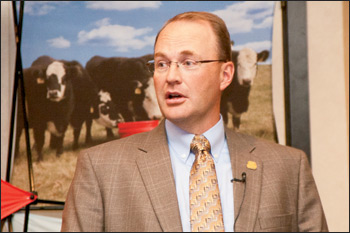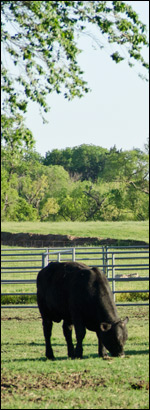Genomic Opportunities for Cattlemen
Megan Rolf, Tonya Amen and Mark McCully share insights on genomics and how purebred and commercial cattlemen can take advantage of the technology.
WICHITA, Kan. (Oct. 3, 2012) — Genomes are like a stack of phone books, said Megan Rolf, Oklahoma State University, at the 2012 National Angus Conference & Tour in Wichita, Kan. The assistant professor of beef cattle management and state extension specialist likened DNA to a string of letters within the book. The people within the books are the coding regions, and the ads within the book are the non-coding regions. Generations change similarly to phone books changing by people moving in and out of town.

Megan Rolf, Oklahoma State University, said the future of genomics involves sequencing the entire genome, which includes great amounts of information — 3 billion base pairs.
SNPs are DNA markers. These SNPS, explained Rolf, are like a “typo” in the phone book. These typos are the most commonly used markers in DNA tests. There are millions of these typos in the bovine genome.
The future of genomics involves sequencing the entire genome, which includes great amounts of information — 3 billion base pairs. Current limits to sequencing are data storage and computing power for analysis, but Rolf said the opportunity is there for the future.
Tonya Amen, director of genetic services at Angus Genetics Inc. (AGI), explained genomic opportunities for Angus seedstock producers.
“If you can use EPDs and understand accuracy, you can use genomic technology,” said Amen.
These expected progeny differences (EPDs) are “the best estimate of an animal’s genetic worth as a parent,” said Amen. Many pieces of information — like pedigree, individual performance, progeny performance and genomic profiles — go into EPDs to affect and increase their accuracy.

Tonya Amen, director of genetic services at AGI, explained genomic opportunities for Angus seedstock producers.
While there are several genomic tests available commercially, only those approved through the American Angus Association’s stringent testing procedures to establish genetic correlation estimates, by trait, are incorporated into national cattle evaluation (NCE) for inclusion in EPD calculations (click here for which genomic tests are included in which traits). Once incorporated through an NCE, that genomic information affects all animals in the database just like weaning weights would.
Thus, Amen affirmed, if you are using Angus EPDs, then you are using genomically enhanced EPDs, whether you know it or not, because they take into account all information.
One major opportunity for seedstock producers to aid their commercial customers is parentage testing. A study spearheaded by Alison Van Eenennaam at the University of California–Davis revealed that, over the course of five years in a multi-sire pasture with eight bulls, the bulls differed in number of progeny from seven calves to 77 calves, and in gross revenue from $4,881 to $55,889. Parentage tests allow producers to find out which bulls are siring the higher quantity of and higher-quality calves.
A sire match option is now available through GeneMax® (GMX), said Mark McCully, assistant vice president and director of supply development at Certified Angus Beef LLC (CAB).

Mark McCully, Certified Angus Beef LLC, explained the genomic tool for commercial producers, GeneMax, and shared market data that shows it really works.
Specifically a commercial producer tool, GMX is a DNA test to predict marbling and postweaning gain in commercial cattle that are high-percentage Angus. It can serve as a selection, marketing and decision tool with commercial replacement heifers or feeder cattle. GMX results, he explained, are presented as a GMX score, GMX marbling and GMX gain and a new optional sire match option.
The GMX score, said McCully, is an economically weighted value for marbling and postweaning gain combined, and is reported as a percentile rank from 1 to 99. He encouraged looking at the composite score instead of the individual component traits of marbling and gain, which are reported on a 1-to-5 scale.
He shared market data that showed the test works. For every 10-unit increase in GMX score, the animal’s value increased by $3.30 per head for every 100 days on feed.
These genomic tests, he concluded, act as “genetic risk management.”
Editor’s Note: This article was written by staff or under contract for Angus Productions Inc. (API). It may not be reprinted without the express permission of API. If you would like to reprint or repost this article, request permission by contacting the editor at 816-383-5200; 3201 Frederick Ave., Saint Joseph, MO 64506. API claims copyright to this website as presented. We welcome educational venues and cattlemen to link to this site as a service to their audience.




